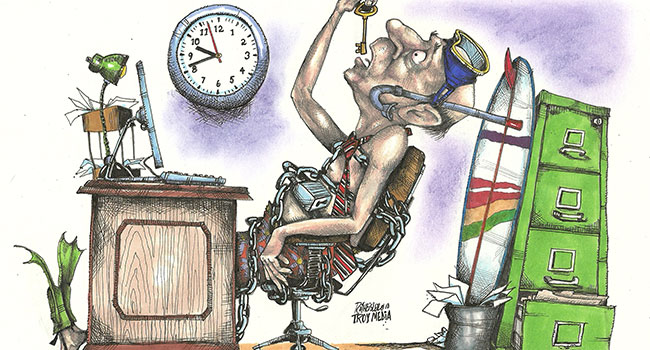 Last year was a surprisingly good year financially for Alberta bureaucrats, unless you were one of the unlucky rubes who doesn’t work for the government.
Last year was a surprisingly good year financially for Alberta bureaucrats, unless you were one of the unlucky rubes who doesn’t work for the government.
Even though the private sector was shedding jobs by the thousands, many Alberta bureaucrats received pay raises during lockdowns, courtesy of Mr. and Ms. Taxpayer.
If that doesn’t seem fair to you, it’s because it’s not.
More than 7,300 Alberta government bureaucrats received a pay raise in 2020, according to documents obtained by the Canadian Taxpayers Federation through a freedom of information request.
And that’s just the tip of the iceberg.
Nearly 8,500 employees at the University of Calgary and University of Alberta also received a pay raise last year. Both universities receive most of their funding from taxpayers.
Pay raises for these 15,800 government employees cost about $41 million in 2020. And that figure doesn’t consider the other provincial government agencies that receive tax dollars, other universities and colleges, school boards and municipal governments.
FROM THE ARCHIVES: Canada’s public sector is getting fatter, and that’s bad news by Matthew Lau
These salary hikes are being paid for by families and businesses who are facing real hardships.
“[During] the last three month shutdown I used almost all my savings to keep us afloat,” said Davita Deering, owner of Southern Roots Hair Design in Lethbridge.
“There’s no more nest egg.”
For many businesses and workers outside of government, the downturn didn’t begin when COVID-19 touched down.
Since 2015, there’s been countless stories outlining the struggles facing workers outside of government. From Albertans leaving their worksites, with “packages in hand, crying and looking distressed,” and oil and gas workers losing their jobs and laying awake “half the night” worried about losing their home to businesses laying off staff just before Christmas, the last five-plus years have been a punch to the gut for Alberta’s private sector.
But there has been no downturn for government.
The last broad-based pay cut for Alberta government bureaucrats was a five per cent cut more than two and a half decades ago, according to research from Secondstreet.org. For city employees in Edmonton and Calgary, there are no records of any unionized employees ever receiving a pay cut.
The CTF is keeping a running tab of the cost of government pay raises since 2015. So far, we’re at $400 million. That number will only go up as we hear back from more government departments.
On top of these pay hikes, there were also thousands of Alberta government employees hired since the downturn began.
It’s clear that there is a class divide in Alberta, but it’s not between businesses and their employees. It’s between those who receive a government paycheque and those forced to pay the growing tab.
Here’s the real kicker: soon the Alberta government will release its 2021 budget, which will be covered top-to-bottom in red ink. And as sure as there’s meat in mutton, academics, politicos and union bosses will all be crying for higher taxes as a way to balance the books.
Before Finance Minister Travis Toews and Premier Jason Kenney even think about raising taxes, they need to address the government-private sector divide. That means 20 per cent pay cuts for politicians and the 2,000 or so bureaucrats making more than $145,000, similar to MLA Drew Barnes’ proposal.
It also means that every government employee needs to share in the downturn and take a cut. If government union bosses aren’t willing to take a pay cut, then Toews and Kenney will need to take a page from former premier Ralph Klein’s playbook and threaten more pink slips.
It can’t just be struggling families and businesses paying the costs of the downturn. It’s long past time for government to start sharing in the burden.
Franco Terrazzano is the Alberta Director of the Canadian Taxpayers Federation.
Franco is a Troy Media Thought Leader. Why aren’t you?
For interview requests, click here. You must be a Troy Media Marketplace media subscriber to access our Sourcebook.
The views, opinions and positions expressed by columnists and contributors are the author’s alone. They do not inherently or expressly reflect the views, opinions and/or positions of our publication.


